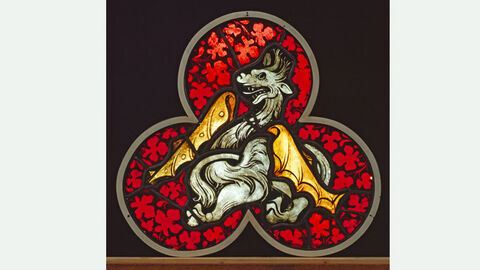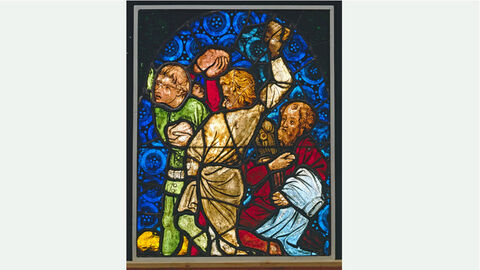After the end of the monarchy, in the 1920s the Hessisches Landesmuseum Darmstadt underwent a period of reorientation. August Feigel, the director of those years, and his curator Heinz Mertens planned to develop the museum into a research centre for German glass art. Through the special exhibition “Deutsches Glas ̶ Zweitausend Jahre Glasveredelung” [German glass—two thousand years of glass craftwork] in the summer of 1935 the public also learnt of this aspiration. Financed through the highly questionable sale of valuable Italian and French drawings and paintings, starting in 1933 the museum increasingly bought up works on the art market. The most important supplier of the coveted medieval stained glass was initially the museum’s business partner of many years, the Berlin art dealer Johannes Hinrichsen.
But in 1938, this changed: purchases of stained glass from Austria and other sources were now made through the Galerie Fischer in Lucerne and later through the gallery’s middleman in Darmstadt, Carl W. Buemming. The reasons for this change are not known. Still, the Galerie Fischer regularly offered high-quality wares exported from Austria for sale in Switzerland. But why was the supply of stained glass of such high quality? After the end of the monarchy, Austria’s ecclesiastical institutions were in debt thanks to new taxes imposed on their income and property, and so in the 1920s and 1930s they sold off many of their artworks and antiques. The global economic crisis also made its presence felt: after the failure of his bank in 1931, the renowned Viennese art connoisseur Stefan von Auspitz’s collection came onto the market.
Two Gothic windows from this collection, the “Dreipass mit Drachen” [Trefoil with dragon], originally from Klosterneuburg abbey near Vienna, and the “Schergengruppe aus einer Steinigung des Hl. Stephanus” [Group of henchmen from a stoning of St. Stephen], originating from the Steiermark, found their way through hitherto unknown channels into the collection of the Viennese doctor Heinrich Keitler. After his death in 1937, the collection was auctioned by the Galerie Fischer in Lucerne under the title “Sammlung eines Wiener Arztes” [Collection of a Viennese Doctor]. Both works were offered as a single lot and remained unsold. Only in 1943 and 1944, through exchange and sale, did they enter the Hessisches Landesmuseum through the art dealer Carl. W. Buemming. But how did the stained glass windows pass from Irma Keitler’s possession to Buemming’s? Research has surprisingly revealed that Theodor Fischer had already bought Keitler’s collection from his widow before the auction and subsequently auctioned it off on his own account. Whether Fischer afterwards kept the unsold windows until 1943, or whether they were owned by someone else in the meantime could not yet be determined.
Udo Felbinger

